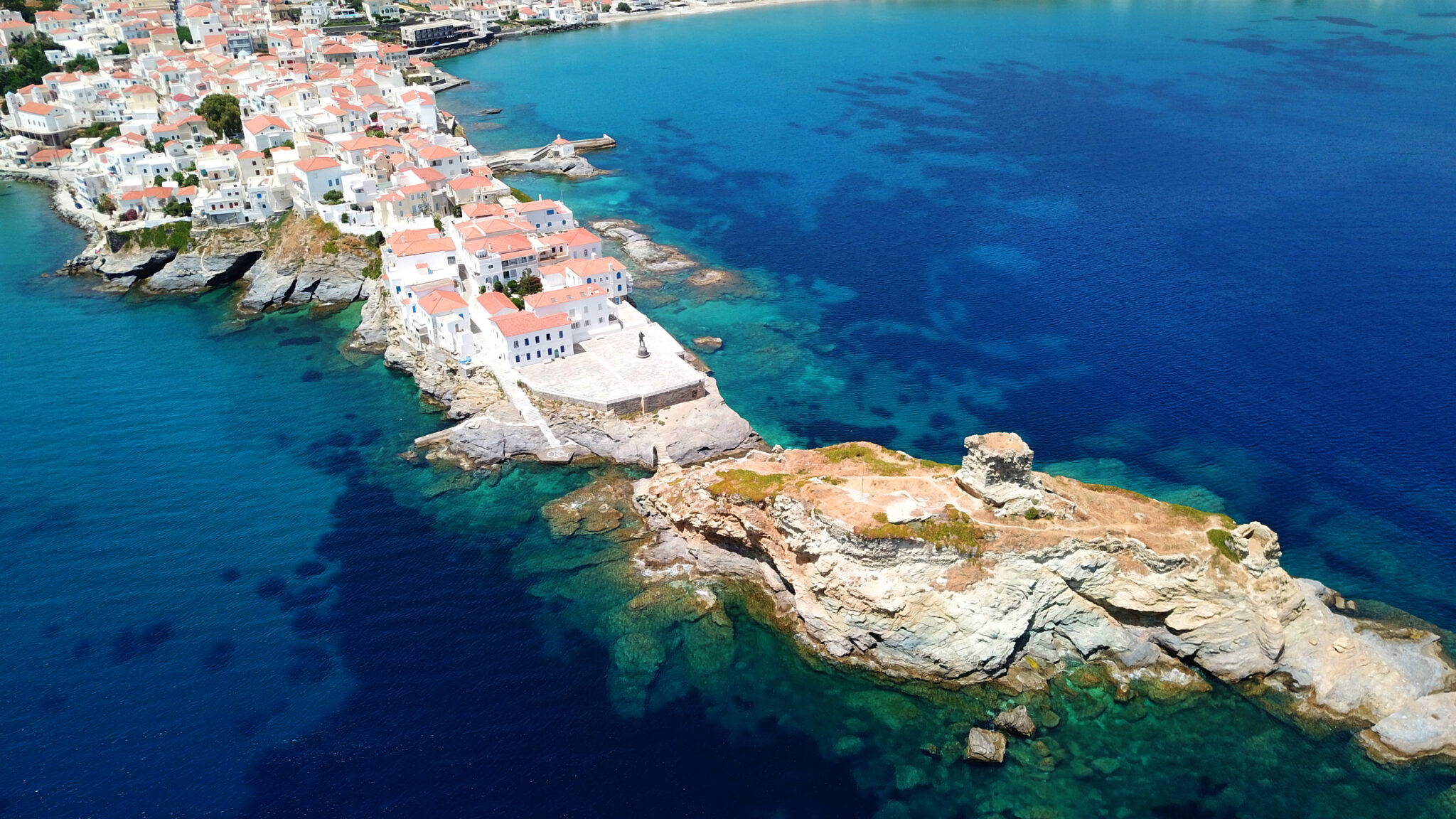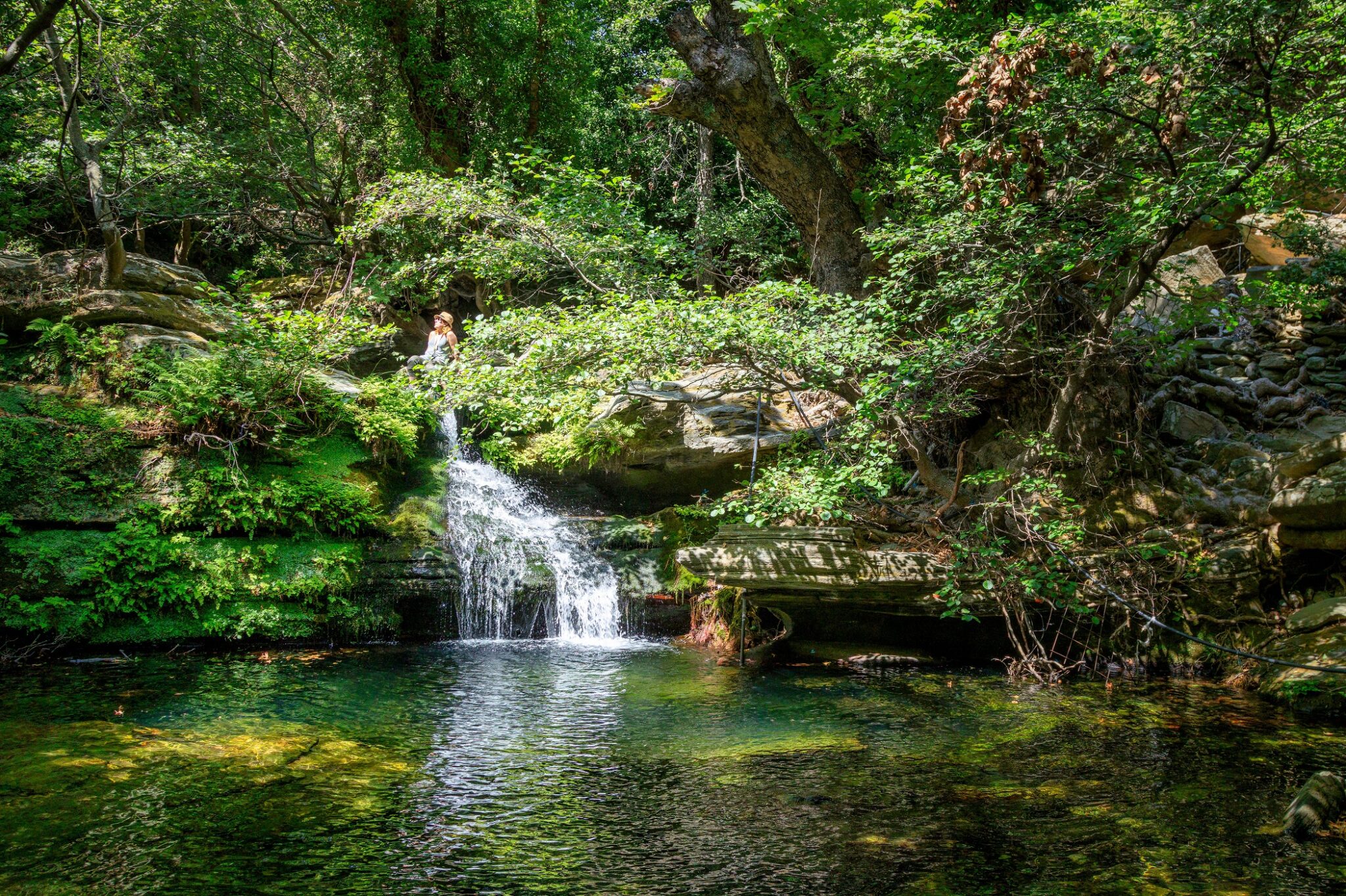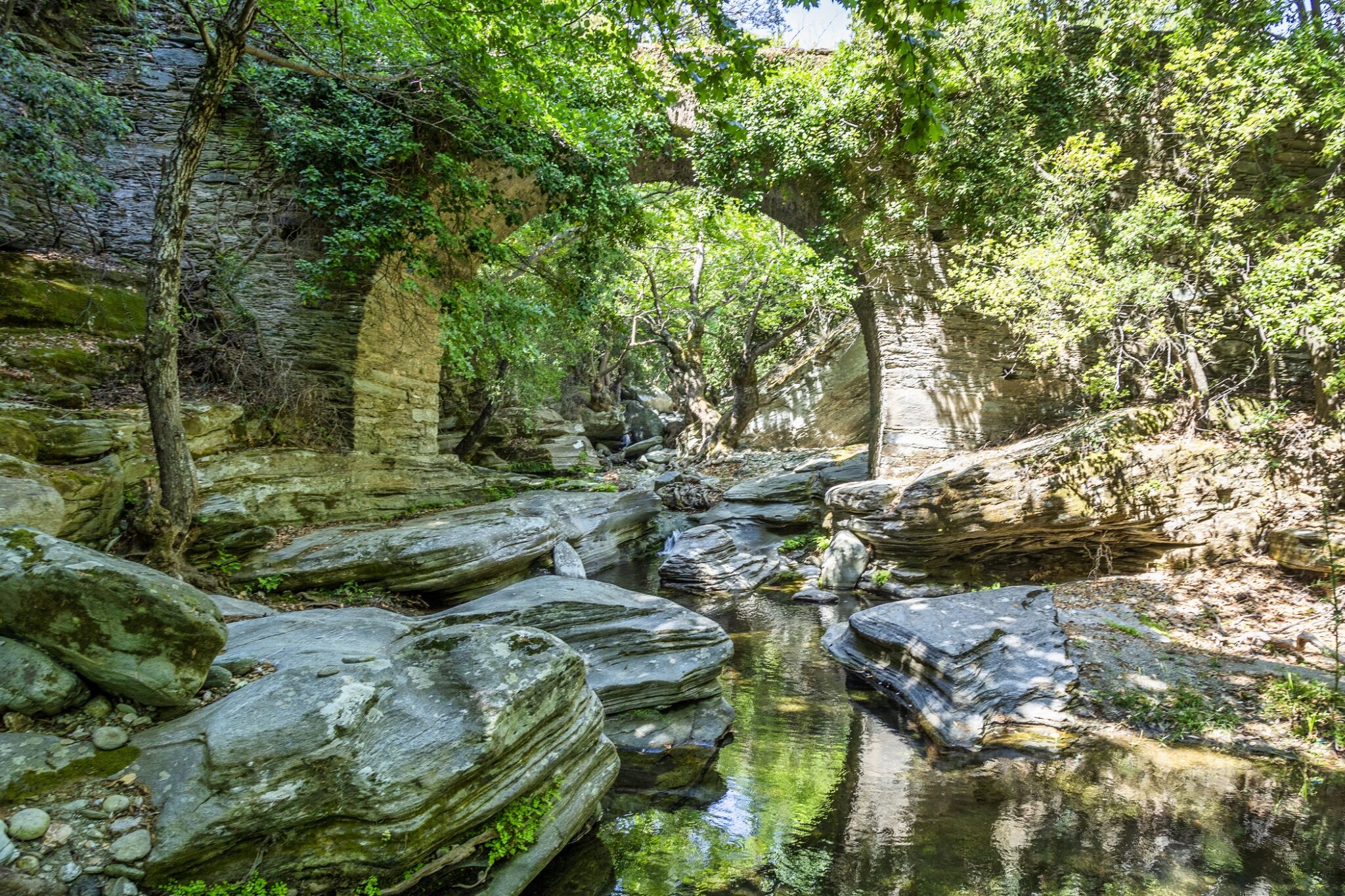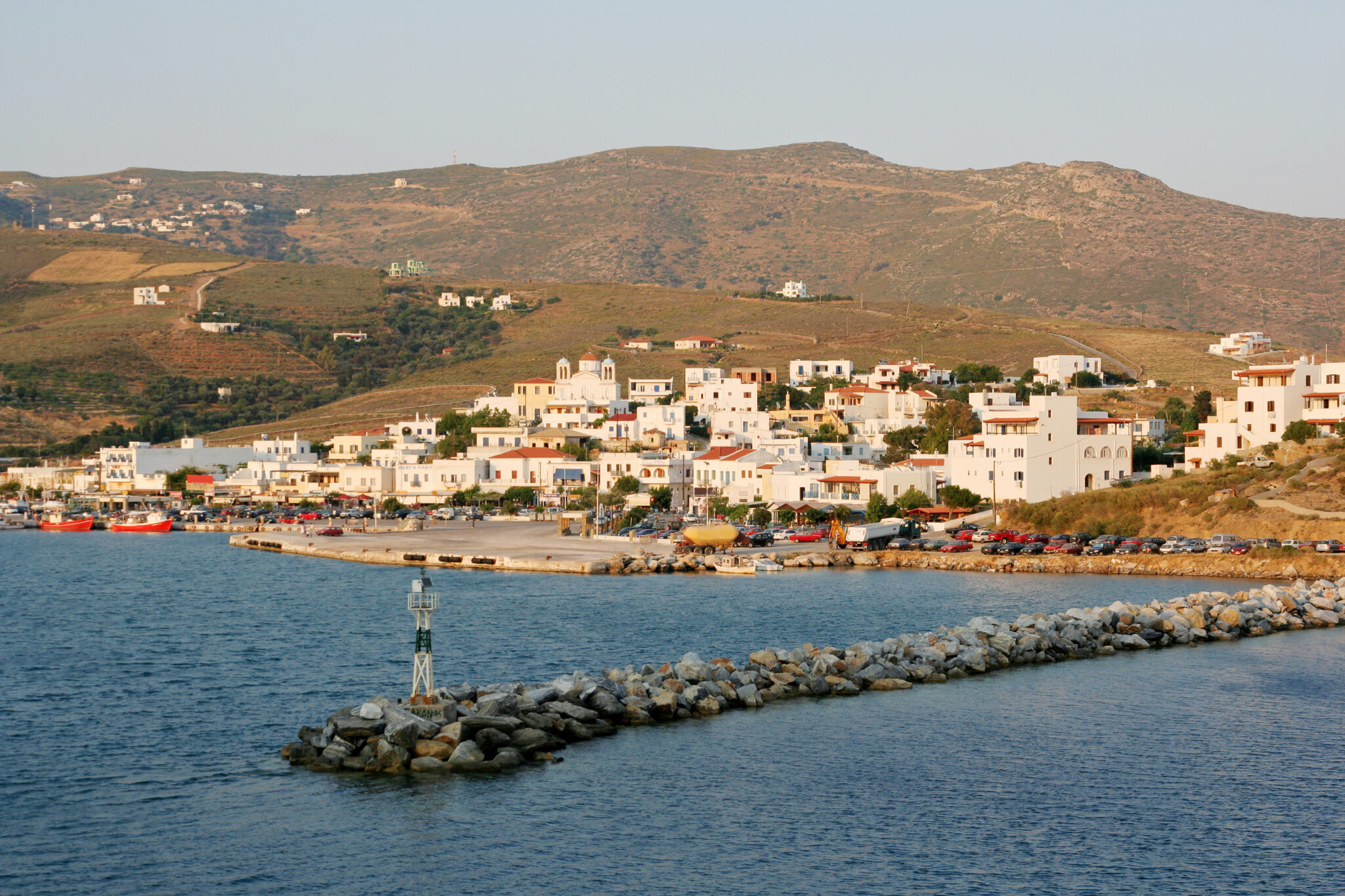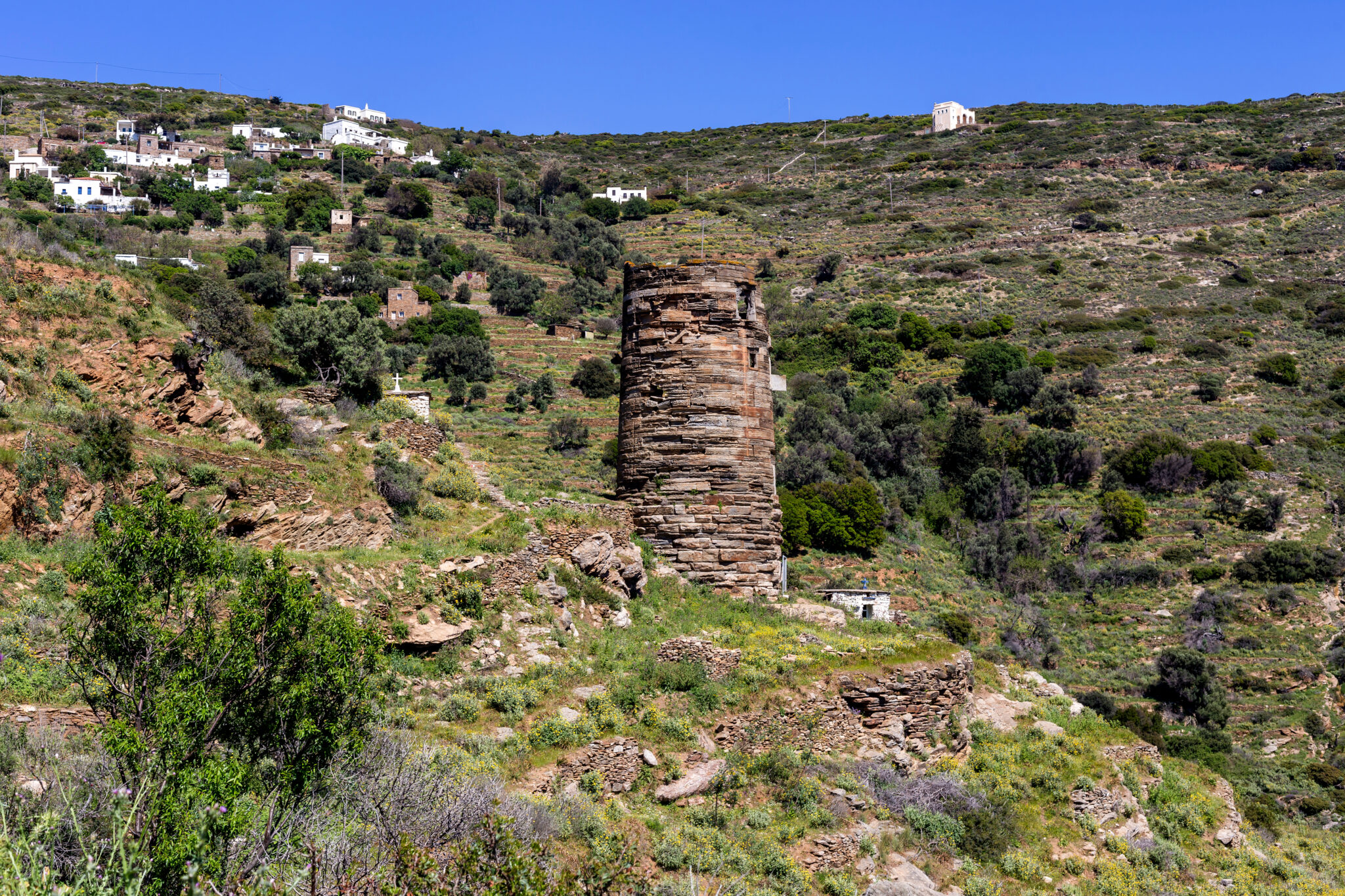In Andros, every visit unveils a new treasure. Venture to the island’s captivating northwestern side, where rugged terrain meets unspoiled beauty. Here, you’ll navigate a labyrinth of dirt roads and ancient paths, each leading to a new discovery. Traverse through lush greenery, cool yourself at cascading waterfalls and marvel at the dramatic coastline sculpted by the Aegean Sea.
Discover the island’s charming inland villages, where time seems to have stood still. Meander through winding cobblestone streets, framed by bougainvillaea-draped stone houses and get lost in the history and culture of these quaint settlements, where you’ll find Byzantine churches and traditional watermills.
Gerolimni Lake and Waterfalls
Nestled in the mountains of Andros, Gerolimni is an emerald oasis of verdant landscapes, cascading waterfalls, and chiming river waters. Fed by the Achla River, Gerolimni lies near Vourkoti, the highest village in Andros. The river carves its way through the terrain, giving birth to a magnificent waterfall and a lively lake, all amid flourishing greenery and vibrant wildflowers that bloom during spring.
Gerolimni’s waters remain cold throughout the summer, providing a refreshing escape on sweltering days. close by is the medieval stone, arched Bridge of Achla that stands strong over the centuries in harmony with nature, showing resilience against turbulent winter swells. It is believed to have been constructed around 1400 A.D. when Andros was an independent Latin state.
The route there is rugged, with some challenging topography. For inexperienced hikers, it is recommended to enlist the help of local tour agencies that offer guided excursions. Seasoned hikers can park at the monastery of Agios Nikolaos and follow path 6 to Vourkoti, passing the Bridge and trekking parallel to the river on an uphill course.
The Watermills
Andros’ watermills, primarily from the early 19th century, showcase the island’s abundant water supply. Records indicate 43 in Korthi (see Sightseeing), 50 in Chora (see Sightseeing), 14 in Arni, and 26 in Amolochos. Today, these pre-industrial marvels are found mainly between Vouni and Syneti (in Korthi), in Frousaios (near Ammolochos), within Dipotamata gorge (see Sightseeing), and by the Great Stream. Witness these fascinating relics and appreciate Andros’ rich hydro-powered history.
Explorations in NW Andros
Navigating Andros Island’s dirt roads is a easy and fun with an off-road vehicle, setting off from Gavrio. Stop by Agios Petros village to admire the historic tower-fryktoria (pirate watchtower) that’s remarkably well-preserved, hailing from the 4th or 3rd century BC. Venture to Vitali beach, passing the 1600-built Pantokrator temple along the way. From Kato Fellos, follow the scenic dirt road to Fassa lighthouse, encountering lovely beaches like Pissolimionas and Vlychada. Take a jaunt from Pano Fellos to Zorkos beach, exploring the quaint rural settlements of Kolivari, Pano and Kato Varidi nearby. Don’t miss Amolochos village, where the lovely 1882 “Mouria” fountain and the impressive 17th-century Giannoulis tower await your discovery.
The Tower of Athenaeus in Strapouries
In Strapouries, you’ll find an abundance of water, lush greenery, charming churches, and the intriguing “Gremnistra” – a perpetually wet, vertical rock. But the real hidden gem lies just off the main road. Behold the Tower of Athenaeus, a grand neoclassical building adorned with turrets and coats of arms, nestled within a verdant estate. Constructed in the 1920s by wealthy Andriot, Ioannis Athenaeus, who amassed his fortune in Egypt, this impressive tower has seen better days – now standing dilapidated and plundered, yet still enchanting to behold.
The Tower of Agios Petros
The Tower of Agios Petros by the moutainside village of the same name stands as a remarkable monument to ancient architecture, dating back to the Hellenistic era, specifically the 4th or 3rd century BC. However, there are some features resembling constructions from the Mycenaean and Minoan periods. Its well-preserved cylindrical structure, made entirely from local slate, rises to a height of 20 meters with a base diameter of 9.40 meters. Inside, the tower has a spiral staircase that connects at least five floors, leading to an opening covered by a massive stone at the top.
The tower was constructed with a strategic purpose in mind, overlooking the sea routes around Andros Island, and serving as a watchtower to protect the surrounding villages and mines from attacks by enemies or pirates. Evidence suggests that it was still in use at the end of the Byzantine period keeping watch over the surrounding area home to the copper mines that operated there from ancient times until the mid-20th century. You can easily access the Tower of Agios Petros from Gavrio town, a 15-minute drive followed by a short walk to the hill’s summit. The tower’s historical significance, impressive architecture, and breathtaking views make it an attraction that should not be missed.
The Streams of Arni
Arnas (Arni) village, founded by the Arvanites (a bilingual Albanian-origin population who settled in Greece), stands proudly on a lofty point in Andros’ interior, much like Vourkoti. Once the region’s centre with bountiful crops, it still boasts fertile land. As you drive the sinuous road towards Batsi, you’ll enter the verdant oasis of Remata (or Reumata), filled with plane trees, cypresses, and olive trees. Camellias and massive hydrangeas adorn the courtyards of scattered homes. Follow the spring near the stream’s end, strolling along the shaded path beside the quaint river with pedestals, until you reach the restored Lebesi olive press. This serene trail ultimately leads you to Arni, completing your picturesque journey.
Read also:
Hiking on Andros: Walking the Restored ‘Calderimia’
Andros: Comprehensive guide to this charming Cyclades island
Andros – An international hiking destination in the Cyclades



